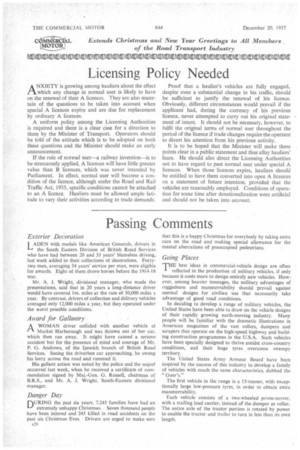Passing Comments
Page 28

Page 29

If you've noticed an error in this article please click here to report it so we can fix it.
Exterior Decoration
LADEN with medals like American Generals, drivers in the South Eastern Division of British Road Services who have had between 20 and 33 years' blameless driving, last week added to their collections of decorations. Fortytwo men, averaging 34 years' service per man, were eligible for awards. Eight of them drove horses before the 1914-18 war.
Mr. A. J. Wright, divisional manager, who made the presentations, said that in 20 years a long-distance driver would have covered lm. miles at the rate of 50,000 miles a year. By contrast, drivers of collection and delivery vehicles averaged only 12,000 miles a year, but they operated under the worst possible conditions.
Award for Gallantry •
A WOMAN driver collided with another vehicle at " Market Harborough and was thrown out of her car, which then ran away. It might have caused a serious accident but for the presence of mind and courage of Mr. P. G. Andrews, of the Ipswich branch of British Road Services. Seeing the driverless car approaching, he swung his lorry across the road and rammed it.
His gallant action was noted by the police and the sequel occurred last week, when he received a certificate of commendation signed by Maj.-Gen. G. Russell, chairman of B.R.S., and Mr. A. J. Wright, South-Eastern divisional manager.
Danger Day
nURING the past six years, 7,245 families have had an 1--" extremely unhappy Christmas. Seven thousand people have been injured and 245 killed in road accidents on the past six Christmas Eves. Drivers are urged to make sure
a26 that this is a happy Christmas for everybody by taking extra care on the road and making special allowance for the mental aberrations of preoccupied pedestrians.
Going Places
best ideas in commercial-vehicle design are often reflected in the production of military vehicles, if only because it costs more to design entirely new vehicles. However, among heavier tonnages, the military advantages of ruggedness and manceuvrability should prevail against normal designs for civilian use that necessarily take advantage of good road conditions.
In deciding to develop a range of military vehicles, the United States have been able to draw on the vehicle designs of their rapidly growing earth-moving industry. Many people will be familiar with the dramatic illustrations in American magazines of the vast rollers, dumpers and scrapers that operate on the high-speed highway and building construction programmes in the U.S.A. • Such vehicles have been specially designed to thrive amidst cross-country conditions, and their huge tyres overcome swampy territory.
The United States Army Armour Board have been inspired by the success of this industry to develop a family of vehicles with much the same characteristics, dubbed the " Goer's."
The first vehicle in the range is a 15-tonner, with exceptionally large low-pressure tyres, in order to obtain extra manceuvrability.
Each vehicle consists of a two-wheeled prime-mover, with a trailing load carrier, instead of the dumper or roller. The entire axle of the tractor portion is rotated by power to enable the tractor and trailer to turn in less than its own length.
RoSPA Anomaly
THERE is disapproval in the Transport and General Workers' Union of one of the rules governing the safedriving competition of the Royal Society for the Prevention of Accidents. It requires that to qualify for an award a driver must have driven for a specified number of days in a year.
It has, however, been pointed out that a man working an II-hour day for slightly fewer than the specified number of days might, in fact, drive in a year for more hours than one who worked continually on a 44-hour week. This is regarded as a serious anomaly.
LR.T.E. Members Promote Road Safety
A N event which is now almost traditionally held on the first Friday in December is the London annual dinnerdance of the Institute of Road Transport Engineers, and this year some 250 members and guests were present.
On this occasion the guest of honour was Maj.-Gen. B. K. Young, C.B.E., M.C., Director-General of the Royal Society for the Prevention of Accidents. In giving the toast of the Institute he referred to the increase of membership during the year and hoped that it would continue to grow. He thought it was largely due to their efforts that a large proportion of the huge fleets of commercial vehicles on the roads were kept in sound mechanical condition. He added that several of the Institute Centres were represented on the Road Safety Committees in their respective areas.
The, president of the Institute, Mr. (3. Mackenzie Junner, responding on its behalf, said that the letters indicating membership were rapidly becoming the hall-mark of the road transport engineer and were an increasingly important factor in the minds of employers.
Rustling of the Pages
THE reception accorded to his lecture "Transport and
the Common Weal" must have been very satisfying to Maj.-Gen. G.. N. Russell. There was a large gathering of members of the Institute of Transport as well as many guests, and there was a considerable measure of agreement with most of the views he put forward. Some questioners asked for further details regarding certain problems to which he had referred and even for solutions to them, but he was not to be caught. In connection with some of these he frankly confessed that they were in the nature of feelers.
At one point in the lecture, where he was referring to the growth of transport, he alluded to references in a commercial transport journal" concerning the growing feeling' that the licensing of haulage vehicles might be becoming too easy. These, no doubt, were the article "Is Licensing Losing its Teeth?" and the leader " Change Too Drastic," in The Commercial Motor dated December 6. This is only one more proof that this journal is followed closely in the highest transport circles.




























































































